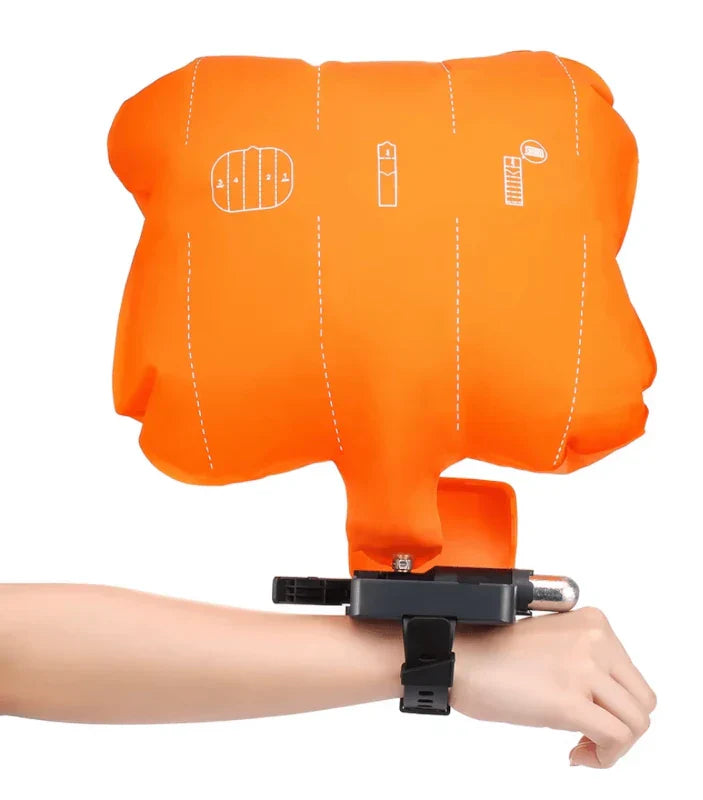This article discusses the subject of anti-drowning bracelets and is part of a series of articles on: Do flotation devices (like PFD) protect against drowning?
Introduction
Drowning is a major public health problem, causing many deaths every year. To help tackle this problem, a number of safety devices have been developed, including anti-drowning bracelets. But are they really effective?
The different types of anti-drowning bracelets and how they work
Anti-drowning bracelets are devices worn on the wrist. Different technologies exist, offering quite different functions depending on the bracelet.
Inflatable anti-drowning bracelet
This type of bracelet is designed to help make water activities safer. It is intended only for people who already know how to swim and who practice an activity in or on the water: swimming, kayaking, scuba diving, etc.
It includes an inflatable bag, a compressed air cartridge and a lever (or tab) for activation. When the mechanism is triggered, it inflates the bag, bringing the wearer back to the surface.
These mechanisms can often be reused, simply by deflating the air chamber and replacing the compressed air cartridge.
Anti-drowning bracelet with alarm
These bracelets are mainly intended for children and are similar to swimming pool alarms. When they are active and submerged, they trigger an audible alarm via a loudspeaker (or audible alarm box).
The wristband fastener must be strong enough to prevent the children from removing the bracelet by themselves.
Most bracelets are designed for swimming pools but not for the sea.
How effective are anti-drowning bracelets?
Inflatable anti-drowning bracelets
An inflatable anti-drowning bracelet can help you get back to the surface, but it does have a few drawbacks:
- When triggered, the person rises to the surface via their wrist. This bracelet alone does not ensure that the head and airways rise to the surface.
- Activation only takes place manually, using the hand that is not wearing the bracelet; this hand must therefore remain free and functional in order to access the device, and the person must be conscious.
- Buoyancy is not guaranteed for all body shapes. You need to choose a device that is suitable for the weight of the person concerned.
- There is no dedicated standard guaranteeing the effectiveness of this type of device.
Anti-drowning bracelets with alarm
These bracelets can be used to warn of unwanted entry into the water, and are generally lightweight and not very intrusive, but they also have a few weaknesses:
- The bracelet emits an alarm but does not act on its own to save a life. You have to rely on the rapid intervention of an outside person (a relative, for example), who must have heard and correctly interpreted the alarm.
- There must be no connection problem between the bracelet and the loudspeaker. If the loudspeaker is too far away from the bracelet or there are devices nearby broadcasting signals at the same frequency, the system will not work.
- The bracelet and speaker must have enough power to operate, so check the batteries regularly.
- It is possible that a device purchased in one country will not work in another. This is because the authorised frequencies of use for this type of signal depend on the country. For example, there is no guarantee that a system purchased in North America will work in Europe, or vice versa.
- Unlike swimming pool alarms, there is no dedicated standard guaranteeing the effectiveness of this type of device.
To sum up, anti-drowning bracelets should never be considered as a miracle solution against drowning. They can be useful in certain situations, but are no substitute for human supervision and other safety devices such as lifejackets.
Safety tips
In spite of wearing an anti-drowning bracelet, it is essential to observe the following safety instructions:
- Never leave children unsupervised near water, even if they are wearing a flotation device such as armbands. Adults must be constantly vigilant.
- Teach your child to swim from an early age. Most programmes start at the age of 4, but it is also possible to learn lifesaving reflexes even earlier.
- Choose supervised swimming areas.
- Comply with safety instructions and swimming bans.
Anti-drowning bracelets can be an additional tool to reinforce water safety, but they are not a miracle solution against drowning. They should not replace vigilance and other preventive measures.
Equipment designed to save from drowning includes lifejackets or anti-drowning solutions, falling under the ISO 12402 standard.




